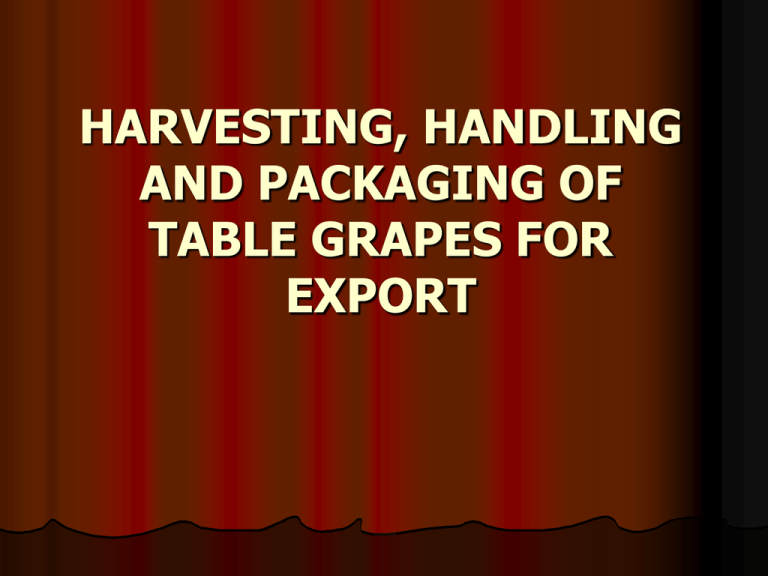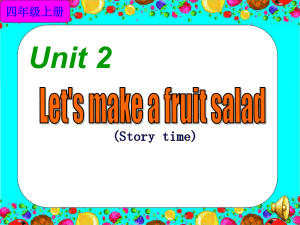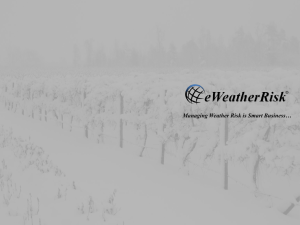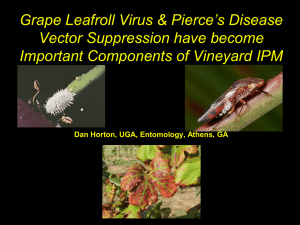harvesting, handling and packaging of table grapes for
advertisement

HARVESTING, HANDLING AND PACKAGING OF TABLE GRAPES FOR EXPORT HARVESTING Standards of grape maturity Sugar level (sweetness) Acid level (acidity taste) Colour of the berries White cultivars: Green, amber, yellow Red cultivars: Pink, light red, dark red Black: Black is only option Sugar:acid ratio (20:1-35:1) Sugar levels International standards for USA, Europe, UK, Far East (developed countries) Minimum sugar levels (degrees Brix) 15.5-17.5 Sugar:Acid 20:1 degrees Brix ratio to 25:1 Cultivar differences are very great Standards are different for various cultivars Refractometer Instrument that measures degrees Brix Helpful instrument to determine the ripeness levels of the grapes Planning essential for the start of harvest Client may discard the fruit if minimum sugar levels are not adhered to Specialised and expensive instrument that needs careful handling, cleaning and regular calibration with distilled water Vital instrument for any grape grower Grape colour (white) GREEN AMBER YELLOW Sultana/Kishmish Sultana/Kishmish Sultana/Kishmish Grape colour (red) PIENK RED DARK RED Crimson Seedless Crimson Seedless Crimson Seedless Grape colour (black) AUTUMN ROYAL MIDNIGHT BEAUTY Local market versus Export market What are the differences?? Why should we think differently about the two? Time between harvest and selling in local market is 1-2 days Time between harvest and selling in export market is 7-30 days FRESHNESS or SHELF LIFE or KEEPING QUALITY Local market sales IDEAL SITUATION To retain peak condition, harvested grapes must be transported as quickly as possible to a facility where it can be cooled rapidly to reduce its field heat This fast cooling should be followed by storage at a constant temperature (0-1 degree Celsius), high humidity (90-98%), suitable air movement and atmospheric composition. MIND SET FOR EXPORT What are the main challenges we face to increase the shelf life of the grapes? TWO MAIN CHALLENGES Decrease temperature as fast as possible after picking Maintain humidity as high as possible as soon as possible after picking Large commercial exportation in USA, SA, Chile, Australia Storage at 0-1 degree Celsius after fast cooling 90-98% Relative Humidity Modern packing facilities -cooling -hygiene -handling Modern cooling and transport facilities Importance of temperature Maintaining the cold chain Maintaining the cold chain Understanding the grape Extremely important to know what happens to the bunches after they have been harvested, because then we know what we can do to prevent fast deterioration of the fruit. Remember: Grapes do not ripen after harvest like some other fruit (bananas, pears), it only deteriorates Aim of post harvest treatments are to limit the rate of deterioration High temperature and low humidity after picking will cause water loss from the stems and berries, and this will increase the rate of deterioration Symptoms of water loss 1-2% weight loss of bunch will have negative effects on berry firmness and stem colour 3-5% weight loss of bunch will cause serious deterioration Bunch discoloration (browning) Drying of bunch stems Loose berries Loss of berry firmness This deterioration is permanent and will cause rejection of the fruit by the market Symptoms of water loss Stem browning due to delays before cooling 32°C/80% Relative Humidity + 6 days at 0°C/80%RH Symptoms of water loss Loss of berry firmness Stem browning Loose berries Browning Good storage conditions Break in cold chain can increase risk of decay and disease development Botrytis rot biggest problem Surface and sub-surface browning of berries can develop in sensitive cultivars Internal browning Grapes before harvest Deterioration as browning after storage Botrytis decay Grey mould Physical bruising Sun burn Effects of water loss No cooling + bad storage <10 days Proper cooling + storage 130 days Realities for Afghan growers We do not have all the specialized equipment and facilities as the developed countries We do not have cultivars with good natural shelf life BUT: What are we going to do to get our grapes in the best possible condition for export? Actions to prevent deterioration Before picking Vineyard grapes Bird management that produced healthy damage Good cluster formation (low compaction) Bee/wasp/other insects damage Physical damage Phytosanitary control of diseases (powdery mildew, Botrytis) Bird damage Wasps/bees Bird control Netting Bags Sun burn Physical blemishes Berry split/cracking and sun spots Compact bunch damages easily Loose bunch with less risk of damage during transport Diseases Powdery mildew Severe mealy bug infestation of clusters Actions to prevent deterioration During picking Boxes for picking must be clean Clean harvesting scissors for picking Clean hands Harvest during cool part of the day (<25°C) Handle fruit carefully Pack only one layer of grapes in box Put soft materials at bottom of box Pick bunches of mostly similar maturity and berry size (uniformity) Transport as quickly as possible to working area Harvesting equipment Harvesting scissors Cluster preparation and cleaning scissors “Clamping” the cluster Wrong way of handling fruit Multi layers in picking boxes Dirty basket Correct way of handling fruit Support cluster at bottom Single layer of fruit in picking box Soft material in bottom to prevent bruising Pick grapes of similar maturity Even maturity Uneven maturity Transport grapes from the field to pack house as quickly as possible Actions to prevent deterioration During handling of clusters in pack house Work hygienic (clean hands, area of working, equipment) Trimming the bad parts of the cluster Rot Bird damage Physical damage, undesirable berries Remove undesirable parts that will make packaging difficult Careful handling of the cluster Limit touching the berries No damage by the scissors to other berries, disease later Handle the bunch by the stem only Work softly with the bunch when picking it up and putting it down Careful handling of clusters Actions to prevent deterioration During packing the fruit in boxes for export Packing only one layer of bunches, no stacking of bunches on top of another Hygienic area and equipment Always clean your hands Boxes must be clean Packaging material must be clean Height of grapes in the box may never be higher than the height of the box Packaging procedures SO2 pad Types of packaging Plastic carry bags Paper bags Loose Panets Sponge (loose) Strength of boxes to prevent pressure on clusters below Practical approaches to Afghanistan limitations Our limitations are: Lack of cultivars with good natural shelf life Shindokghani Taifi Delays between picking and packing shed Lack of proper cooling facilities after picking and during transport Lack of proper control of humidity Lack of proper packaging materials TRY TO LIMIT THE HANDLING OF THE GRAPES TO AS LITTLE AS POSSIBLE Field preparation and packing Cooling options Straw house for packing and storage Evaporative cooling by wetting the sides during the day and thereby creating lower temperatures inside as well as increased humidity Transport options Creating air flow for bulk loads Transport options Creating air flow through the load Stacking the boxes inside with space for air flow Packaging options Rice straw/dry grasses as liners in the bottom of boxes to limit physical damage No “pressure” of grapes between boxes The use of plastic/polyethylene liners inside the boxes are the only probable means of ensuring less water loss during transport Open truck transport of grapes without humidity protection is extremely risky But: Can result in “sweating” of grapes Good airflow in the shipment will increase the rate of water loss of the berries and stems Use of plastic liner will also decrease physical damage of the fruit in the wooden/carton box Physical damage=juice=fast deterioration (rot) Loose packaging Bagged packaging Summary We do not have the modern advantages, accept it Pick the fruit during the coolest part of the day (early morning) Pick the grapes carefully and only pack as one layer before trimming and cleaning Work in a shaded place (straw house) Store the grapes well ventilated with good humidity Cover the grapes inside the boxes with plastic liner to limit water loss Get the grapes to the market as quickly as possible Be inventive in your efforts to keep the grapes cool and as humid as possible











